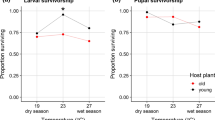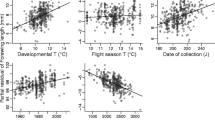Abstract
Phenotypic plasticity, or the ability of organisms to produce different phenotypes depending upon environmental factors, may be adaptive in varying environments. However, because environments differ in many ways and organisms consist of many traits perfect phenotype-environment matches are unlikely. Studies that investigate multiple interacting environmental factors and the plastic responses of multiple traits should increase our understanding of the limits of adaptive plasticity. We experimentally examined the effects of variation in temperature and photoperiod on the seasonally plastic, and likely adaptive, melanization of a temperate butterfly, Pieris rapae. Although several melanin-based traits changed in response to temperature and photoperiodic variation, these traits tended to fall into two ‘trait groups’ consisting of traits covarying positively. However, these two trait groups responded to environmental factors, particularly temperature, in independent and sometimes opposing ways, with one increasing and the other decreasing in melanization with increased temperature. In some cases, plastic responses were complex and non-linear. Furthermore, when temperature and photoperiod were manipulated orthogonally, we sometimes detected interactive effects on melanization. These complex responses to two environmental cues may reflect sub-optimal responses or may occur if the two cues together provide more reliable information about future conditions than would either cue alone. Our results highlight the limits of studies of phenotypic plasticity that consider only single environmental factors and limit treatments to just two levels.



Similar content being viewed by others
References
Benjamini Y, Hochberg Y (1995) Controlling the false discovery rate—a practical and powerful approach to multiple testing. J R Stat Soc B 57:289–300
Bradshaw WE, Holzapfel CM (2010) Insects at not so low temperature: climate change in the temperate zone and its biotic consequences. In: Denlinger DL, Lee RE (eds) Low temperature biology of insects. Cambridge University Press, Cambridge, pp 242–275
Chaput-Bardy A, Ducatez S, Legrande D, Baguette M (2014) Fitness costs of thermal reaction norms for wing melanisation in the large white butterfly (Pieris brassicae). PLoS ONE 9(2):e90026
Chevin L, Lande R (2013) Evolution of discrete phenotypes from continuous norms of reaction. Am Nat 182:13–27
Chevin L, Lande R (2015) Evolution of environmental cues for phenotypic plasticity. Evolution 69:2767–2775
DeWitt TJ, Sih A, Wilson DS (1998) Costs and limits of phenotypic plasticity. Trends Ecol Evol 13:77-81
Ellers J, Boggs CL (2004) Functional ecological implications of intraspecific differences in wing melanization in Colias butterflies. Biol J Linn Soc 82:79–87
Gavrilets S, Scheiner SM (1993) The genetics of phenotypic plasticity V. Evolution of reaction norm shape. J Evol Biol 6:31–48
Getty T (1996) The maintenance of phenotypic plasticity as a signal detection problem. Am Nat 148:378–385
Ghalambor CK, McKay JK, Carroll SP, Reznick DN (2007) Adaptive versus non-adaptive phenotypic plasticity and the potential for contemporary adaptation in new environments. Funct Ecol 21:94–407
Heinrich B (1990) Is reflectance basking real? J Exp Biol 154:31–44
Hill DS (1987) Agricultural insect pests of temperature regions and their control. Cambridge University Press, Cambridge
Hoffmann RJ (1973) Environmental control of seasonal variation in the butterfly Colias eurytheme I. Adaptive aspects of a photoperiodic response. Evolution 27:387–397
Hoffmann RJ (1978) Environmental uncertainty and evolution of physiological adaptation in Colias butterflies. Am Nat 112:999–1015
Hoverman JT, Relyea RA (2015) Prey responses to fine-scale variation in predation risk from combined predators. Oikos 125:254–261
Jeong HC, Kim JA, Im HH, Jeong HU, Hong MY, Lee JE, Han YS, Kim I (2009) Mitochondrial DNA sequence variation of the swallowtail butterfly, Papilio xuthus, and the cabbage butterfly, Pieris rapae. Biochem Gen 47:165–178
Kingsolver JG (1988) Thermoregulation, flight, and the evolution of wing pattern in pierid butterflies: the topography of adaptive landscapes. Am Zool 28:899–912
Kingsolver JG (1995) Fitness consequences of seasonal polyphenism in western white butterflies. Evolution 49:942–954
Kingsolver JG (1996) Experimental manipulation of wing pigment pattern and survival in western white butterflies. Am Nat 147:296–306
Kingsolver JG, Huey RB (1998) Evolutionary analyses of morphological and physiological plasticity in thermally variable environments. Am Zool 38:545–560
Kingsolver JG, Watt WB (1983) Thermoregulatory strategies in Colias butterflies: thermal stress and the limits to adaptation in temporally varying environments. Am Nat 121:32–55
Kingsolver JG, Wiernasz DC (1987) Dissecting correlated characters: adaptive aspects of phenotypic covariation in melanization pattern of Pieris butterflies. Evolution 41:491–503
Kingsolver JG, Wiernasz DC (1991a) Seasonal polyphenism in wing-melanin patterns and thermoregulatory adaptation in Pieris butterflies. Am Nat 137:816–830
Kingsolver JG, Wiernasz DC (1991b) Development, function, and the quantitative genetics of wing melanin pattern in Pieris butterflies. Evolution 45:1480–1492
Moran NA (1992) The evolutionary maintenance of alternative phenotypes. Am Nat 139:971–989
Murren CJ (2012) The integrated phenotype. Int Comp Biol 52:64–76
Murren CJ, Maclean HJ, Diamond SE, Steiner UK, Heskel MA, Handelsman CA, Ghalambor CK, Auld JR, Callahan HS, Pfennig DW, Relyea RA, Schlichting CD, Kingsolver J (2014) Evolutionary change in continuous reaction norms. Am Nat 183:453–467
Padilla DK, Adolph SC (1996) Plastic inducible morphologies are not always adaptive: the importance of time delays in a stochastic environment. Evol Ecol 10:105–117
Quinn GP, Keough MJ (2002) Experimental design and data analysis for biologists. Cambridge University Press, Cambridge
Scheiner SM, Holt RD (2012) The genetics of phenotypic plasticity X. Variation versus uncertainty. Ecol Evol 2:751–767
Scott JA (1986) The butterflies of North America: a natural history and field guide. Stanford University Press, Stanford
Shapiro AM (1968) Photoperiodic induction of vernal phenotype in Pieris protodice Boisduval and Le Conte (Lepidoptera: Pieridae). Wasmann J Biol 26:137–149
Shapiro AM (1971) Occurrence of a latent polyphenism in Pieris virginiensis (Lepidoptera: Pieridae). Entomol News 82:13–16
Shapiro AM (1973) Photoperiodic control of seasonal polyphenism in Pieris occidentalis Reakirt (Lepidoptera: Pierdae). Wasmann J Biol 31:291–299
Shapiro AM (1976) Seasonal polyphenism. Evol Biol 9:259–333
Shapiro AM (1978) The evolutionary significance of redundancy and variability in phenotypic-induction mechanisms of pierid butterflies (Lepidoptera). Psyche 85:275–283
Shapiro AM (1982) Redundancy in pierid polyphenisms: pupal chilling induces vernal phenotype in Pieris occidentalis (Pieridae). J Lep Soc 36:174–177
Stillwell RC, Wallin WG, Hitchcock LJ, Fox CW (2007) Phenotypic plasticity in a complex world: interactive effects of food and temperature on fitness components of a seed beetle. Oecologia 153:309–321
Stoehr AM (2010) Responses of disparate phenotypically plastic, melanin-based traits to common cues: limits to the benefits of adaptive plasticity? Evol Ecol 24:287–298
Stoehr AM, Goux H (2008) Seasonal phenotypic plasticity of wing melanisation in the cabbage white butterfly, Pieris rapae L. (Lepidoptera: Pieridae). Ecol Entomol 33:137–143
Storey J (2003) The positive false discovery rate: a Bayesian interpretation and the q-value. Ann Stat 31:2013–2035
Takami Y, Koshio C, Ishii M, Fujii H, Hidaka T, Shimizu I (2004) Genetic diversity and structure of urban populations of Pieris butterflies assessed using amplified fragment length polymorphism. Molec Ecol 13:245–258
Troetschler RG, Malone CM, Bucago ER, Johnston MR (1985) System for rearing Pieris rapae (Lepidoptera:Pieridae) on a noncruciferous artificial diet developed for Manduca sexta (Lepidoptera:Sphingidae). J Econ Entomol 78:1521–1523
Tuomaala M, Kaitala A, Rutowski RL (2012) Females show greater changes in wing colour with latitude than males in the green-veined white butterfly, Pieris napi (Lepidoptera: Pieridae). Biol J Linn Soc 107:899–909
Valladares F, Matesanz S, Guilhaumon F, Araújo MB, Balaguer L, Benito-Garzón M, Cornwell W, Gianoli E, van Kleunen M, Naya DE, Nicotra AB, Poorter H, Zavala MA (2014) The effects of phenotypic plasticity and local adaptation on forecasts of species range shifts under climate change. Ecol Lett 17:1351–1364
van Baalen M (2014) Adaptation, conflicting information, and stress. Biol Theory 9:431–439
Verhoeven KJF, Simonsen KL, McIntyre LM (2005) Implementing false discovery rate control: increasing your power. Oikos 108:643–647
Via S, Gomulkiewicz R, de Jong G, Scheiner SM, Schlichting CD, Van Tienderen P (1995) Adaptive phenotypic plasticity: consensus and controversy. Trends Ecol Evol 10:212–217
Watt WB (1968) Adaptive significance of pigment polymorphisms in Colias butterflies I. Variation of melanin pigment in relation to thermoregulation. Evolution 22:437–458
Watt WB (1969) Adaptive significance of pigment polymorphisms in Colias butterflies, II. Thermoregulation and photoperiodically controlled melanin variation in Colias eurytheme. Proc Natl Acad Sci USA 63:767–774
Webb SE, Shelton AM (1988) Laboratory rearing of the imported cabbageworm. Food Life Sci Bull 122:1–6
Acknowledgments
We thank Holly Aviles, Haley Coffmann, Randi Delong, Shelby Miller, Ashni Patel, Tierra Patterson and Nicole Risselman for assistance in data collection, and two anonymous reviewers for helpful suggestions to improve the manuscript. Financial support was provided by the Butler University College of Liberal Arts and Sciences and Department of Biological Sciences, and from a Senior Research Grant (to A.M.S.) from the Indiana Academy of Science. All applicable institutional and/or national guidelines for the care and use of animals were followed.
Author contribution statement
AMS conceived and designed the research, EMW conducted the research, AMS analyzed the data and wrote the manuscript with editorial assistance from EMW.
Author information
Authors and Affiliations
Corresponding author
Ethics declarations
Conflict of interest
The authors declare no conflict of interest.
Additional information
Communicated by Roland A. Brandl.
Rights and permissions
About this article
Cite this article
Stoehr, A.M., Wojan, E.M. Multiple cues influence multiple traits in the phenotypically plastic melanization of the cabbage white butterfly. Oecologia 182, 691–701 (2016). https://doi.org/10.1007/s00442-016-3694-2
Received:
Accepted:
Published:
Issue Date:
DOI: https://doi.org/10.1007/s00442-016-3694-2




